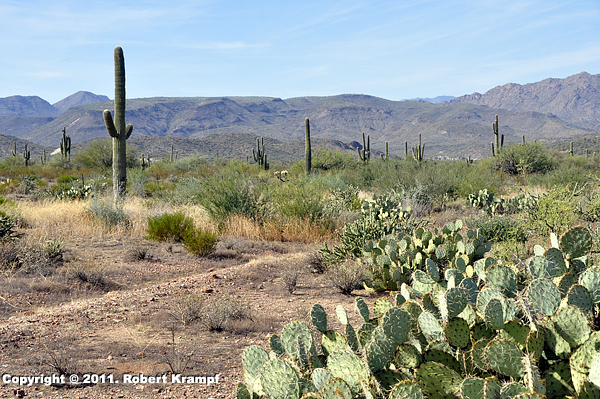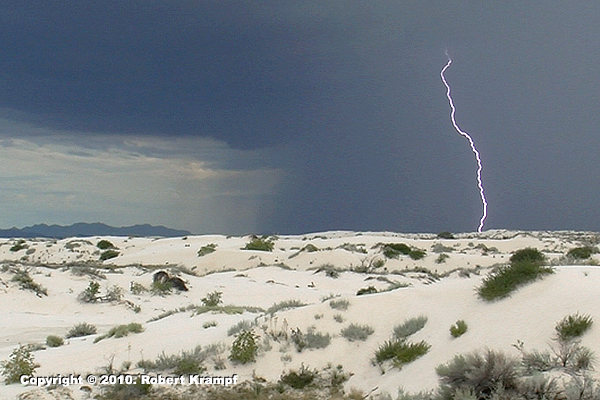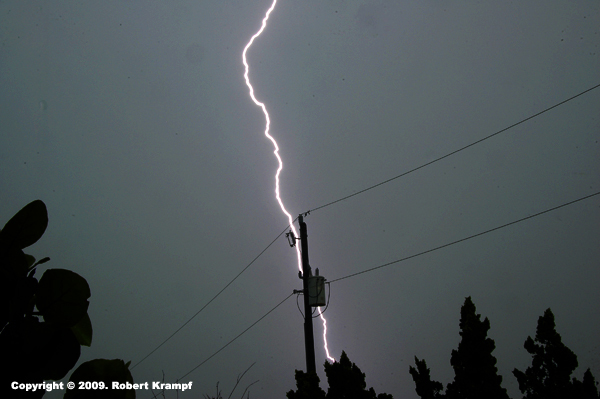Here are some science questions to help you test your knowledge of the Next Generation Sunshine State Standards.
The questions are chosen randomly, so this quest will be different each time you reload the page.
Back to the Grade 5 standards.

How hot does an area have to be to be classified as a desert?
Answer:
Deserts are defined by lack of precipitation, not by temperature. They are areas where precipitation minus evaporation yields less than 10 inches of rain per year. The largest desert on Earth is in Antarctica, a very cold place.
Click to see which state standards this question tests, and which of my videos, experiments, and other resources support that topic.
Florida
SC.5.E.7.6 Describe characteristics (temperature and precipitation) of different climate zones as they relate to latitude, elevation, and proximity to bodies of water.
| Weather and Climate | video |
| Review Weather-7 | practice |
| Review Weather-9 | practice |
Utah
UT.4.V.1.c Locate examples of areas that have characteristics of wetlands, forests, or deserts in Utah.
| Review Weather-7 | practice |
| Review Weather-9 | practice |
NGSS

How can there be rain if this area is a desert?
Answer:
It is important to understand the difference between climate and weather. Weather is what is happening now. Climate is determined by looking at the weather data over a long period of time, often several decades. To be classified as a desert climate, the area has an average annual rainfall of 7.87 inches of rain or less. That tells us that it does sometimes have rain, just not very often.
Click to see which state standards this question tests, and which of my videos, experiments, and other resources support that topic.
Florida
SC.2.L.17.2 Recognize and explain that living things are found all over Earth, but each is only able to live in habitats that meet its basic needs.
| Hunting with an Umbrella | video, free, ClosedCaptions, Updated |
| A Walk in the Park | video, checked |
| Review Weather-9 | practice |
SC.5.E.7.6 Describe characteristics (temperature and precipitation) of different climate zones as they relate to latitude, elevation, and proximity to bodies of water.
| Weather and Climate | video |
| Review Weather-7 | practice |
| Review Weather-9 | practice |
SC.6.E.7.2 Investigate and apply how the cycling of water between the atmosphere and hydrosphere has an effect on weather patterns and climate.
| The Water Cycle | video, checked |
| Weather and Climate | video |
| Cloud Types | video |
| Nephoscope | video, checked |
| Pine Cone Weather | text page, free |
| Review Weather-8 | practice |
| Review Weather-9 | practice |
| Review Weather-10 | practice |
SC.6.E.7.6 Differentiate between weather and climate.
| Weather and Climate | video |
| Review Weather-9 | practice |
Utah
UT.4.V.1.a Compare the physical characteristics (e.g., precipitation, temperature, and surface terrain) of Utah's wetlands, forests, and deserts.
| Weather and Climate | video |
| Review Weather-9 | practice |
UT.4.V.1.c Locate examples of areas that have characteristics of wetlands, forests, or deserts in Utah.
| Review Weather-7 | practice |
| Review Weather-9 | practice |
NGSS
MS-ESS2-6 Develop and use a model to describe how unequal heating and rotation of the Earth cause patterns of atmospheric and oceanic circulation that determine regional climates.
| Cloud Formation, part 2 | video |
| Global Science | video, ClosedCaptions |
| Weather and Climate | video |
| Review Weather-9 | practice |
3-ESS2-2 Obtain and combine information to describe climates in different regions of the world.
| Weather and Climate | video |
| Review Weather-9 | practice |

A lightning bolt has a huge amount of energy. Which of these kinds of energy is NOT a major component of lightning?
-
Heat
No. A lightning bolt can heat the air to over 30,000 °C (54,000 °F) -
Electrical
No. A lightning bolt has a tremendous amount of electrical energy, often several hundred million volts, and several hundred thousand amperes. -
Sound
No. Thunder, the sound energy produced by a lightning bolt, is so loud that it can often be heard up to ten miles away. -
Chemical
Yes. While a lightning bolt can cause chemical changes, very little of the bolt's energy is converted to chemical energy.
Click to see which state standards this question tests, and which of my videos, experiments, and other resources support that topic.
Florida
SC.3.P.10.1 Observe and describe some basic forms of energy, including light, heat, sound, electrical, and the energy of motion.
| Making a Screamer | video, free, Updated |
| The Singing Glass | video, checked |
| Whistle Stick | video, text page, blog, free, checked |
| Electrostatic Charges | video |
| Noisy String | video, checked |
| Spoon Bells | video, checked |
| Review Energy-5 | quest |
| Review Energy-2 | practice |
SC.4.P.10.1 Observe and describe some basic forms of energy, including light, heat, sound, electrical, and the energy of motion.
| Spoon Bells | video, checked |
| The Singing Glass | video, checked |
| Radioactive | video, Updated, checked |
| Electricity | video, free, Updated |
| Measuring Calories | video, ClosedCaptions, checked |
| Measuring Kinetic and Potential Energy | video, checked |
| Electrostatic Charges | video |
| Why Things Go Bang | video |
| Noisy String | video, checked |
| Bean Power | text page |
| Calories: Measuring the Energy | text page, free |
| Review Energy-5 | quest |
| Review Energy-2 | practice |
SC.5.P.10.1 Investigate and describe some basic forms of energy, including light, heat, sound, electrical, chemical, and mechanical.
| Sunglass Science: Birefringence | video, free, Updated |
| Noisy String | video, checked |
| Spoon Bells | video, checked |
| Making a Screamer | video, free, Updated |
| The Singing Glass | video, checked |
| Radioactive | video, Updated, checked |
| Electricity | video, free, Updated |
| The Science of Pizza | video, checked |
| Measuring Calories | video, ClosedCaptions, checked |
| Measuring Kinetic and Potential Energy | video, checked |
| Solar Power | video, checked |
| Why Things Go Bang | video |
| Calories: Measuring the Energy | text page, free |
| Review Energy-5 | quest |
| Review Energy-2 | practice |
Utah
UT.8.IV.4.b Trace the conversion of energy from one form of energy to another (e.g., light to chemical to mechanical).
| High Bounce | video, checked |
| Measuring Kinetic and Potential Energy | video, checked |
| The Rollback Can | video, free, Updated |
NGSS
4-PS3-2 Make observations to provide evidence that energy can be transferred from place to place by sound, light, heat, and electric currents.
| How Heat Moves | video, checked |
| Solar Power | video, checked |
| Bottle Tones, part 1 | video, checked |
| Bottle Tones, part 2 | video, checked |
| Why Things Go Bang | video |
| Noisy String | video, checked |
| Spoon Bells | video, checked |
| Making a Screamer | video, free, Updated |
| The Singing Glass | video, checked |
| Electricity | video, free, Updated |
| The Science of Pizza | video, checked |
| Heating a Balloon | video, ClosedCaptions, checked |
| Simple Circuits | video, checked |
| Doppler Effect | video, checked |
| A Real Tuning Fork | text page |
| Comparing How Sound Moves Through Liquids and Gases | text page |
| Review Energy-2 | practice |
Which of the following forms of ice commonly occurs in the summer when air temperatures are well above freezing?

A: Hail

B: Snow

C: Frost

D: Freezing rain
Think about it, and when you think you know the answer, then click here.
While other kinds of frozen precipitation can form at high altitudes, in the summer they usually melt long before they reach the ground. Hail is made up of large enough chunks of ice that it usually remains frozen all the way to the ground, even during warm weather.
Click to see which state standards this question tests, and which of my videos, experiments, and other resources support that topic.
Florida
SC.5.E.7.4 Distinguish among the various forms of precipitation (rain, snow, sleet, and hail), making connections to the weather in a particular place and time.
| Photographing Snowflakes | video, checked |
| Building a Rain Gauge, part 2 | video, checked |
| Building a Rain Gauge, part 1 | video, checked |
| Snow Rollers | text page |
| Review Weather-6 | practice |
| Review Weather-3 | practice |
Utah
UT.4.II.2.a Observe and record effects of air temperature on precipitation (e.g., below freezing results in snow, above freezing results in rain).
| Photographing Snowflakes | video, checked |
| Building a Rain Gauge, part 2 | video, checked |
| Building a Rain Gauge, part 1 | video, checked |
| Review Weather-6 | practice |
| Review Weather-3 | practice |
NGSS
3-ESS2-1 Represent data in tables and graphical displays to describe typical weather conditions expected during a particular season.
| Nephoscope | video, checked |
| Pine Cone Weather | text page, free |
| Review Weather-6 | practice |
| Review Weather-4 | practice |
| Review Weather-3 | practice |
| Review Space-5 | practice |
| Review Space-8 | practice |
| Review Weather-5 | practice |
MS-ESS2-5 Collect data to provide evidence for how the motions and complex interactions of air masses results in changes in weather conditions.
| Cloud Formation, part 1 | video, ClosedCaptions, checked |
| Cloud Types | video |
| Nephoscope | video, checked |
| Pine Cone Weather | text page, free |
| Review Weather-1 | practice |
| Review Weather-2 | practice |
| Review Weather-6 | practice |
| Review Weather-4 | practice |
| Review Weather-3 | practice |

Which of the following is likely a sign that it will rain soon?
-
Rising temperature
No. A warm air mass moving into your area might bring rain, but it also might bring sunny weather. Rising temperature by itself is not a good indicator of rain. -
Decreasing humidity
No. The humidity at ground level does not play much of a role in the formation of rain in the clouds. Just before it rains, the precipitation could cause the humidity to increase, but it would not cause it to decrease. -
Wind out of the west
No. Any weather front moving in from the west could cause winds, even if it was bringing clear, sunny weather. -
Falling barometric pressure
Yes! Low pressure fronts are commonly associated with rain and storms, so falling barometric pressure is a good indicator that rain may be on the way.
Click to see which state standards this question tests, and which of my videos, experiments, and other resources support that topic.
Florida
SC.5.E.7.3 Recognize how air temperature, barometric pressure, humidity, wind speed and direction, and precipitation determine the weather in a particular place and time.
| Building a Rain Gauge, part 1 | video, checked |
| Nephoscope | video, checked |
| Building a Rain Gauge, part 2 | video, checked |
| Pine Cone Weather | text page, free |
| Review Weather-5 | practice |
| Review Weather-4 | practice |
Utah
UT.4.II.3.a Identify and use the tools of a meteorologist (e.g., measure rainfall using rain gauge, measure air pressure using barometer, measure temperature using a thermometer).
| Building a Rain Gauge, part 1 | video, checked |
| Nephoscope | video, checked |
| Building a Rain Gauge, part 2 | video, checked |
| Pine Cone Weather | text page, free |
| Review Weather-4 | practice |
NGSS
3-ESS2-1 Represent data in tables and graphical displays to describe typical weather conditions expected during a particular season.
| Nephoscope | video, checked |
| Pine Cone Weather | text page, free |
| Review Weather-6 | practice |
| Review Weather-4 | practice |
| Review Weather-3 | practice |
| Review Space-5 | practice |
| Review Space-8 | practice |
| Review Weather-5 | practice |
MS-ESS2-5 Collect data to provide evidence for how the motions and complex interactions of air masses results in changes in weather conditions.
| Cloud Formation, part 1 | video, ClosedCaptions, checked |
| Cloud Types | video |
| Nephoscope | video, checked |
| Pine Cone Weather | text page, free |
| Review Weather-1 | practice |
| Review Weather-2 | practice |
| Review Weather-6 | practice |
| Review Weather-4 | practice |
| Review Weather-3 | practice |
The questions are chosen randomly, so this quest will be different each time you reload the page.
Non-subscriber
